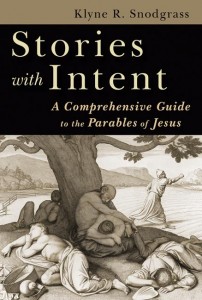Blog
Nov 4
What Is a Parable?

Here is an instructive definition of what a parable is, from Snodgrass’ Stories with Intent, the same book mentioned in the last post.
The immediate aim of a parable is to be compellingly interesting, and in being interesting it diverts attention and disarms. A parable’s ultimate aim is to awaken insight, stimulate the conscience, and move to action. The primary reason Jesus’ parables are stories with intent is, as we will see, that they are prophetic instruments, the tool especially of those who have a message from God. They do not occur in sections of the Bible focused on Torah or history or in the writings of the early church. They are used by those who are trying to get God’s people to stop, reconsider their ways, and change their behavior. Biblical parables reveal the kind of God that God is and how God acts, and they show what humanity is and what humanity should and may become. Parables are not merely informative. Like prophets before him, Jesus told parables to prompt thinking and stimulate response in relation to God. Parables usually engage listeners, create reflection, and promote action. They are pointed and clinching arguments for a too often slow-minded or recalcitrant audience. They seek to goad people into the action the gospel deserves and the kingdom demands. One of the major problems of Christian churches, of Western Christianity in particular, is our stultifying passivity. The parables compel us – for Christ’s sake literally – to do something! Parables do not seek the “mild morality†about which Kierkegaard lamented but radical cross-bearing, God-imitating response worthy of the name “conversion.â€
In most cases then a parable is an expanded analogy used to convince and persuade. As we will see, this is the way ancient Greeks also used the term, and it is sufficiently broad to cover the majority of the ways the Evangelists use the word. The logic of Jesus’ parables is proportional analogy. Corresponding to the German terms Sache and Bild, the English terms tenor and vehicle are used to explain how analogy functions. Tenor refers to the theme being compared, the item for which insight is sought, and vehicle refers to the pictorial image, the parable, the instrument by which insight is conveyed. An analogy explicitly or implicitly draws one or more points of resemblance. For example, a disciple is to God (tenor) as a slave is to a master (vehicle) with respect to unsurpassable obligation (point of resemblance).  According to John Sider every parable labeled as a parable in the Gospels involves more than one point of resemblance – the exact opposite of Jülicher. Analogy by its very nature can easily become “allegorical.†(emphasis original, pp. 8-9)







